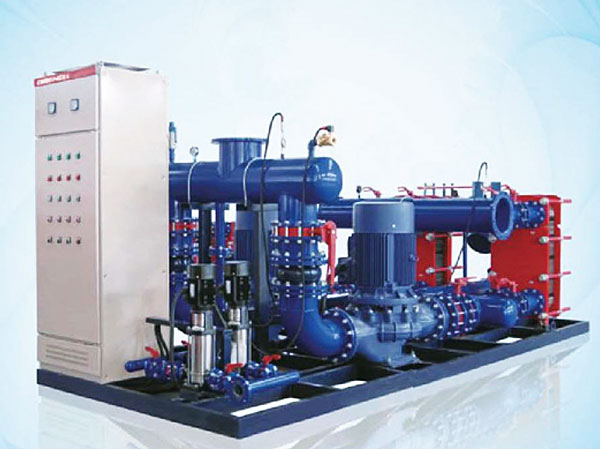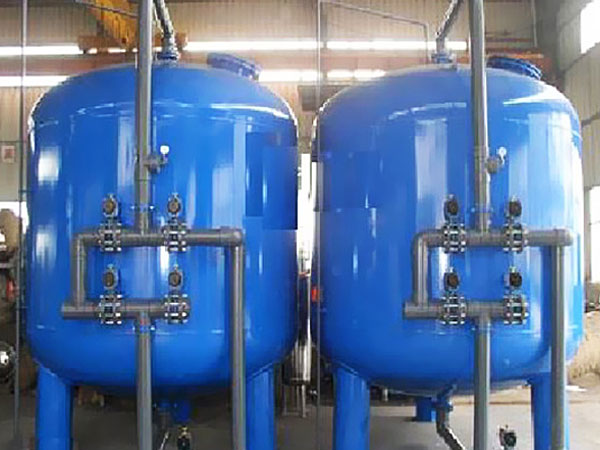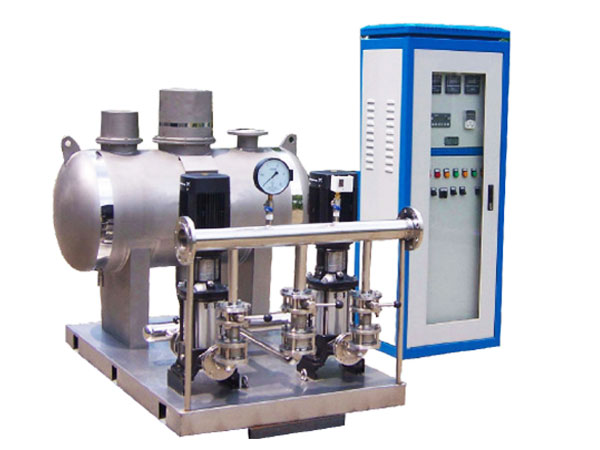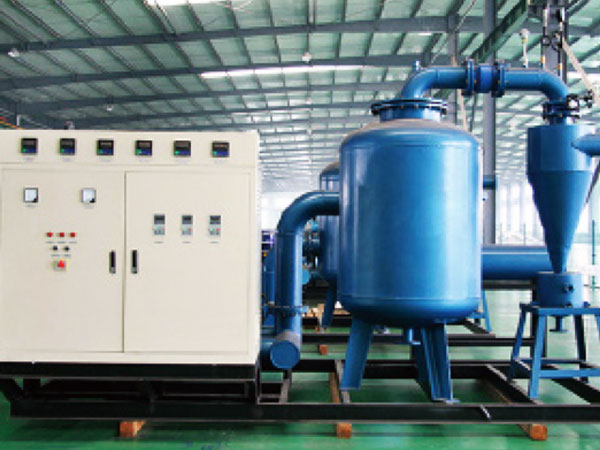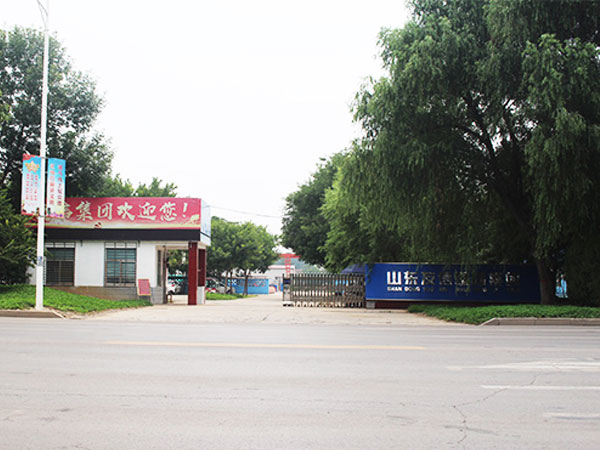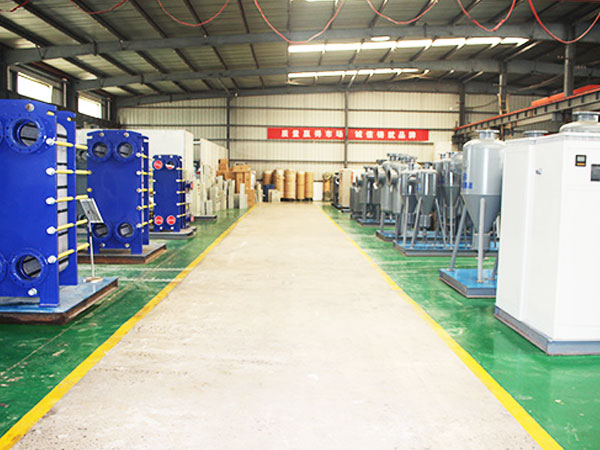Heat Exchanger Equipment
Contact Us
Contact Us
产品详细
Double thread pipe steam-water heat exchange unit
1. Composition of double-threaded tube heat exchanger:
Double screw tube heat exchanger is composed of main components such as tube box, shell, tube bundle and so on. The tube bundle is the core of the double-threaded tube heat exchanger, where the heat exchange tube acts as a heat-conducting element and determines the thermal performance of the heat exchanger. Another basic element that has a greater impact on the thermal performance of the heat exchanger is the baffle (or baffle). The tube box and shell mainly determine the pressure-bearing capacity of the double-threaded tube heat exchanger and the safety and reliability of operation and operation.
2. Working principle of double threaded tube heat exchanger:
Double-threaded tube heat exchanger belongs to the partition wall heat exchanger. The fluid channel formed in the heat exchange tube is called the tube side, and the fluid channel formed outside the heat exchange tube is called the shell side. When the tube side and the shell side pass through two fluids with different temperatures, the fluid with higher temperature transfers heat to the fluid with lower temperature through the heat exchange tube wall, the fluid with higher temperature is cooled, and the fluid with lower temperature is heated, And then achieve the purpose of two-fluid heat exchange process.
3. Main technical characteristics of double-threaded tube heat exchanger:
The general double-threaded tube heat exchanger has the following main technical characteristics compared with other types of heat exchangers:
1. High temperature and high pressure resistance, strong and reliable;
2. The manufacturing application has a long history and the manufacturing process and operation maintenance inspection technology are mature;
3. Wide selection of materials and wide application range.
In addition to the above characteristics, the double-threaded tube heat exchanger of our factory has the following main technical characteristics:
1. The inner and outer surfaces of the heat exchange tubes of the double-spiral tube heat exchanger of the helical tube (including elliptical helical tube) are helical. The tube-side fluid flows forward in a three-dimensional spiral motion state in the tube. When the flow rate is very low, sufficient turbulence can be achieved , Thereby overcoming the shortcomings of low heat transfer coefficient of the fluid boundary film in the tube side of the double-threaded tube heat exchanger, significantly improving the total heat transfer coefficient of the heat exchanger, and the fluid resistance loss is small;
2. The arc double-threaded tube heat exchanger is an improved version of the ribbed tube heat exchanger, which has all the advantages of the ribbed tube heat exchanger with high heat transfer coefficient and not easy to scale. It also overcomes the ribbed tube heat exchanger The heater is limited by the manufacturing process and the tube wall is thin (not more than 1.0mm), the heat exchange tube is short (not more than 5m), and the tube plate and the heat exchange tube must be connected with a welding sleeve (does not meet the GB151 national mandatory standard requirements) The shortcomings, etc., fully comply with GB151 national standards, durable.
3. The heat exchange tubes of the ion beam double-threaded tube heat exchanger and nickel-based double-threaded tube heat exchanger are processed by ion beam or nickel-based carburizing, and the surface has a uniform micro-convex and concave surface to reduce the surface tension of the heat exchange fluid In order to improve the heat transfer coefficient of the fluid boundary film, especially for condensing heat transfer, the film-like condensation is changed to bead condensation, which greatly improves the heat transfer coefficient of the condensing boundary film and the total heat transfer coefficient of the heat exchanger. The corrosion resistance of the heat exchange tube of the double-threaded tube heat exchanger with nickel-based permeation layer is improved. The carbon steel tube can be used to replace the general stainless steel tube, and the cost is significantly reduced;
4. Swirl baffle double-threaded tube heat exchanger is to transform the traditional planar arcuate baffle or annular baffle into a spiral progressive swirl baffle, which further strengthens the shell side fluid disturbance and has no short path , So as to increase the heat transfer coefficient of the shell-side fluid boundary film and reduce the resistance loss of the shell-side fluid;
5. The double-threaded tube heat exchanger of the baffle uses grid-shaped baffles to replace the traditional planar arcuate baffles or annular baffles to further strengthen the disturbance of the shell-side fluid and improve the heat transfer coefficient of the shell-side fluid boundary film. Reduce the fluid resistance loss of shell side.
4. Main technical parameters:
Maximum design pressure: less than 10MPa maximum design temperature: 650 ℃
Maximum shell diameter: 2600mm Maximum heat exchange area of single machine: 4000m2
Heat exchange tube specifications: φ10—φ70mm heat exchange tube length: 100—12000mm
Surface quality of heat exchange tube: ordinary tube, ion beam tube, nickel-based permeable tube
Types of heat exchange tubes: arc tube, spiral tube, elliptical spiral tube
Baffle elements: bow baffles, ring baffles, swirl baffles, baffles
Common materials: low carbon steel, low alloy steel, stainless steel, copper (heat exchange tube)
5. Implementation standards:
▶ Product standard
"Double Threaded Tube Heat Exchanger" GB151-2014
"Diversion type volumetric water heater and half volume type water heater (U-shaped tube bundle)" CJ / T 163-2002
▶ Engineering standards
"Code for Construction Quality Acceptance of Building Water Supply, Drainage and Heating Engineering" GB50242-2002
6. Overview of double threaded tube heat exchange unit:
Central heating is the main symbol of urban modernization and the main measure to save energy, improve the environment and promote production. In the central heating system, the computer room that connects the heating network and the local system to ensure user comfort, safety and economic operation is called a heat exchange unit. The heat exchange unit is the main part of the heating system. Our company has developed a high-efficiency and energy-saving heat exchange unit based on the heat supply situation in China. After several years of operation and continuous innovation, we have absorbed advanced technologies at home and abroad to create a new generation of heat exchange units with a high degree of automation.
7. The main advantages are:
1. Saving investment;
2. Easy to design and shorten the engineering design cycle;
3. Reduce the occupied area by about 60%;
4. Microcomputer automatic control and automatic monitoring temperature adjustment system;
5. Can be unattended;
6. With communication interface, it can be directly connected with the central computer to realize centralized monitoring.
8. Structure of double-threaded tube heat exchange unit:
The heat exchange unit is mainly composed of shell and tube heat exchanger, circulation pump, cut-off valve, filter, check valve, microcomputer automatic control system, regulating valve, safety valve, calorimeter and flow meter (according to user needs). (For details, please refer to the random equipment drawings)
9. The characteristics of the double threaded tube heat exchange unit:
1. The maximum temperature of the high-temperature steam-water heat exchange unit is 260 ℃ and the working pressure is 1.6MPa.
2. The total resistance of the cold side (secondary side) of the heat exchange unit is ≤0.1MPa, and the total resistance of the hot side (primary side) is ≤0.07MPa.
3. The heat exchange unit has the characteristics of automatic temperature control and automatic monitoring, which can ensure the constant temperature and constant pressure of the secondary pipe network.
4. Single or multiple heat exchange units can be used in parallel.
10. Working Principle of Double-Threaded Tube Heat Exchange Unit:
1. Working principle of starting operation of heat exchange unit:
The heat exchange unit has five pipeline entrances and exits, namely the primary side heat medium import and export and the secondary side heating water import and export, a water supply system import and microcomputer automated electrical control system. The fully automatic microcomputer control cabinet has two operating states, automatic and manual, and has various parameter display functions such as temperature. When set to the automatic state (set the manual switch to the automatic position), the secondary side circulation pump will automatically enter the running state. The heating return water on the secondary side passes through the heat exchange unit and is sent to the heating user after the temperature rises. On the contrary, it must be set to manually press the start button on the manual side to make the circulating pump enter the operating state, and the circulating water on the secondary side operates according to the above process. The secondary side adopts constant temperature and constant pressure for water delivery.
2. Electrical system
First open the door of the control cabinet of the microcomputer automatic control system, check whether the external power line is correct, after confirming that it is correct, push the air switch down to the "closed" position, and then close the door of the control cabinet of the microcomputer control system and lock it. The power lamp has instructions to determine the operation mode of the heating system. If automatic operation is used, turn the selector switch to the automatic operation position. The microcomputer controller will automatically monitor after power is turned on, and automatically give a running signal after confirmation that there is no fault. The circulation pump starts the water circulation of the secondary pipe network. After 10 seconds, the temperature control valve receives the opening signal of the controller, and the hot side medium enters the heat exchanger for exchange. When the pressure of the secondary pipe network fluctuates, the frequency conversion in the automatic system The system will act to ensure the constant water pressure of the secondary pipe network; when the secondary water temperature changes, the controller receives the signal from the temperature transmitter of the secondary pipe network to turn on and off the temperature control of the primary pipe network The valve is used to adjust the temperature of the secondary water and keep it constant (see the random electrical schematic diagram for details).
The main functions of the fully automatic microcomputer control system are as follows:
1. Temperature monitoring range: 0-150 ℃ (water), 0-260 ℃ (steam)
2. Pressure monitoring range: 0-20bar;
3. The temperature control valve is automatically closed after a sudden power failure to prevent the secondary vaporization of the medium;
4. After power failure, the system can automatically reset the power transmission operation without human operation;
5. With manual function;
6. The secondary pipe network has a pressure protection function. When the pressure is too high, the safety valve automatically opens to release pressure to ensure the safety of the system;
7. With constant temperature, constant pressure and alarm functions.
11. Installation of Double-Threaded Tube Heat Exchange Unit:
1. The heat exchange unit can be placed directly on the indoor concrete foundation (100mm above the surface) and fixed with anchor bolts or expansion bolts;
2. The highest point of the water pipe system connected to the heat exchange unit should be equipped with an automatic exhaust valve;
3. When the heat exchanger is assembled upstairs, it only needs to check the bearing capacity of the floor slab;
4. See the random installation drawing for the location of the nozzle of the heat exchange unit, and the random electrical drawing for electrical wiring;
5. The unit can be operated by connecting the pipeline and power supply;
12. The operation, debugging and shutdown maintenance of the double threaded tube heat exchange unit:
1. The heat source, outdoor heat network, and heating system connected to the heat exchange unit must pass the construction, installation, and acceptance, and the entire system is unblocked and leak-free before the heat exchange unit can start operation;
2. It is better to use treated demineralized water for the entire system
3. Trial steering of circulating water pump (the pipeline pump is strictly forbidden to run without water).
4. The water supply and return valves of the equipment are fully open, the steam inlet valve is fully closed, and the condensate valve is fully closed.
5. The inlet valve of the circulating water pump is fully opened. After the water pump is in operation, adjust the water outlet of the water pump to the normal working pressure (the inlet and outlet valves of the standby water pump are fully closed).
6. After the pump is running normally, start to send steam (or high temperature water). Before sending steam, first open the condensate valve (if it is 2 steam-water and 1 water-water heat exchanger, the water-water heat exchanger should be opened at the same time) High temperature water inlet and heated water outlet), then slowly open the steam valve to send steam.
7. The water supply temperature should rise slowly after the steam is delivered. If the temperature rises too fast, the small steam valve should be closed, and the large steam valve should be opened slowly. Generally, it should be controlled within 1-2 hours. The hot water reaches the design temperature (such as 2 steam-water and 1 water-water heat exchanger should be first Slowly turn on one steam-water heat exchanger. After reaching the design temperature requirements, start another steam-water heat exchanger in the same way).
8. The water supply constant pressure is set according to the constant pressure parameters. For details, see the manual of the frequency conversion constant pressure control cabinet.
9. ① Three circulating water pumps, two running and one standby, and should be switched regularly. ②Adopt automatic timing conversion, please refer to the instruction manual of the electric control cabinet of the heat exchange unit.
13. Shutdown and maintenance:
1. Close the steam inlet valve first, and the water pump continues to run. After the water temperature decreases, close the water outlet valve of the running water pump, stop the pump, then close the condensate valve, and finally cut off the main power supply of the electric control box.
2. In case of emergency shutdown (such as sudden power failure, etc.), the steam valve must be emergency closed, and then the power supply should be cut off.
3. After shutdown: the heat exchanger pipes of the unit should be shut down for water maintenance. If the local temperature is below 0 ℃, the unit is equipped with a vent valve to vent the water to prevent frost cracking.
14. Failure and treatment of double threaded tube heat exchange unit:
1. If the temperature of the upper and lower parts of the heat exchanger is low, it should be checked whether the condensate valve is fully open and the drainage is unblocked. If necessary, the drain bypass valve is opened to ensure that the drainage is smooth and the temperature of the upper and lower parts of the heat exchanger is equal.
2. During steam delivery, when water hammer or vibration occurs in the pipeline, immediately close the steam delivery valve, fully open the steam trap, and then slowly steam the heating pipe until the steam delivery is normal.
3. If the return water pressure continues to rise after a period of operation (the difference between the supply and return water pressure is too small), you should check whether the decontamination device or the system is blocked, otherwise the system load is too small and the system load should be increased.
|
Fault phenomenon |
the reason |
Approach |
|
The power indicator of the electric control cabinet is off, the voltmeter has no indication |
1. The power supply is not connected |
1. Connect the power cord |
|
Pump reversal |
Wiring error |
Adjust the phase sequence |
|
Poor heat transfer effect |
Scaling, clogging |
Cleaning, descaling and dredging pipelines |
|
Heat exchanger leakage |
1. Not clamped |
1. Tighten properly |
|
Heat exchanger internal leakage |
Cracks and perforations in heat exchange tubes |
Replace the heat exchange tube |
|
Pipeline flange interface leakage |
Uneven gaskets, tight bolts |
Replace the gasket and tighten the bolt |
ONLINE / MESSAGES
Tel:0534-2580018
E-Mail:1133231096@163.com
版权信息
CopyRight © 2020 Youxin Group ICP: 鲁ICP备18012254号-1 Powered by www.300.cn


